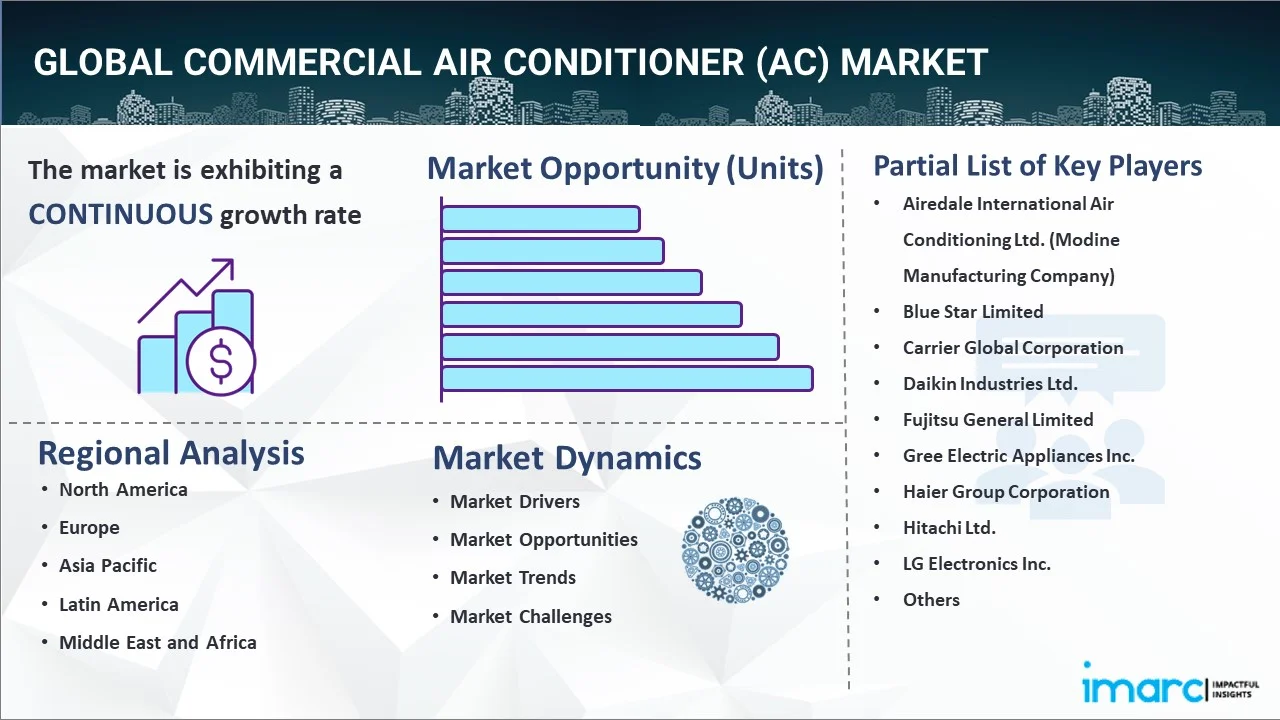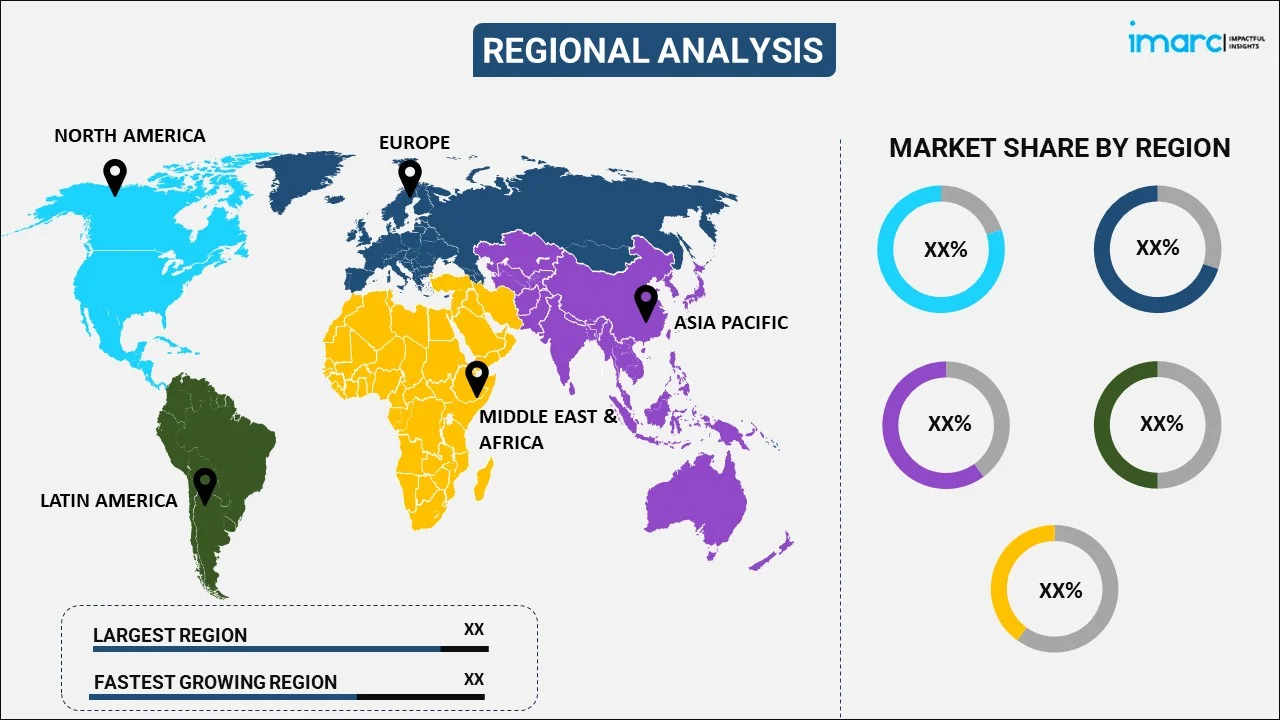
Commercial Air Conditioner (AC) Market by Type (Chillers, Split Units, Packaged Unit, Variable Refrigerant Flow (VRF), and Others), Installation Type (New Installation, Retrofit), End User (Healthcare, Educational/Institutional, Public/Government, Retail, Hospitality, Manufacturing), and Region 2025-2033
Market Overview:
The global commercial air conditioner (AC) market size reached 19.3 Million Units in 2024. Looking forward, IMARC Group expects the market to reach 28.4 Million Units by 2033, exhibiting a growth rate (CAGR) of 4.15% during 2025-2033. The rising installation of advanced and energy-efficient cooling systems in hospitality establishments, elevating temperatures and humidity levels worldwide, and increasing acceptance of ACs as utility products represent some of the key factors driving the market.
|
Report Attribute
|
Key Statistics
|
|---|---|
|
Base Year
|
2024 |
|
Forecast Years
|
2025-2033
|
|
Historical Years
|
2019-2024
|
| Market Size in 2024 | 19.3 Million Units |
| Market Forecast in 2033 | 28.4 Million Units |
| Market Growth Rate (2025-2033) | 4.15% |
Commercial air conditioners are electrical appliances designed to chill, heat, and dehumidify air in defined, usually enclosed spaces. They rely on a refrigeration cycle to treat the air and work by drawing the warm air from the room and replacing it with cooler air. They generally combine the heating and cooling systems into a single rooftop unit for optimum energy consumption. They aid in maintaining a comfortable temperature and air quality for customers and employees in commercial spaces of all sizes. They are widely available in different cooling capacities, power, and settings, such as chillers, central air conditioning systems, packaged units, and multi-split and ductless mini-split air conditioners. Since these units require a significant amount of space, they are commonly installed on the rooftops of buildings, which also assists in preventing noise from disturbing the inhabitants or business operations. As a result, commercial air conditioners are extensively deployed in various commercial settings, including shopping malls, offices, schools, gyms, hotels, restaurants, shops, and movie theaters.

Commercial Air Conditioner (AC) Market Trends:
Due to the rapid growth of the hospitality and travel and tourism industries, there is a surge in the installation of advanced systems in hotels, restaurants, and resorts to improve guest satisfaction, comfort, and retention. This, coupled with the escalating demand for energy-efficient cooling systems, especially from regions with soaring temperature and humidity levels, represents the primary factor driving the market growth. Additionally, the combined effects of ozone layer depletion and constantly worsening climate conditions owing to elevating air pollution levels and global warming have led to a gradual increase in the average temperature worldwide. In line with this, the rising acceptance of air conditioning systems as utility products instead of luxury items on account of climate change has augmented the product demand to maintain cool and comfortable temperatures in commercial spaces. Furthermore, the introduction of stringent government regulations on refrigerants is prompting manufacturers to develop energy-efficient and eco-friendly products. Along with this, the launch of innovative product variants by key players, such as commercial air conditioners embedded with energy-saving features and inverter and air purification technologies, has catalyzed the market growth. Other factors, including rapid urbanization and industrialization, increasing construction of commercial spaces, improving lifestyles, and ongoing technological advancements, are also anticipated to provide a positive thrust to market growth.
Key Market Segmentation:
IMARC Group provides an analysis of the key trends in each segment of the global commercial air conditioner (AC) market, along with forecasts at the global, regional, and country levels from 2025-2033. Our report has categorized the market based on type, installation type, and end user.
Type Insights:
-market-sagment.webp)
- Chillers
- Split Units
- Packaged Unit
- Variable Refrigerant Flow (VRF)
- Others
The report has provided a detailed breakup and analysis of the commercial air conditioner (AC) market based on the type. This includes chillers, split units, packaged unit, variable refrigerant flow (VRF), and others. According to the report, packaged unit represented the largest segment.
Installation Type Insights:
- New Installation
- Retrofit
A detailed breakup and analysis of the commercial air conditioner (AC) market based on the installation type has also been provided in the report. This includes new installation and retrofit.
End User Insights:
- Healthcare
- Educational/Institutional
- Public/Government
- Retail
- Hospitality
- Manufacturing
The report has provided a detailed breakup and analysis of the commercial air conditioner (AC) market based on the end user. This includes healthcare, educational/institutional, public/government, retail, hospitality, and manufacturing. According to the report, hospitality represented the largest segment.
Regional Insights:

- North America
- United States
- Canada
- Asia-Pacific
- China
- Japan
- India
- South Korea
- Australia
- Indonesia
- Others
- Europe
- Germany
- France
- United Kingdom
- Italy
- Spain
- Russia
- Others
- Latin America
- Brazil
- Mexico
- Others
- Middle East and Africa
The report has also provided a comprehensive analysis of all the major regional markets, which include North America (the United States and Canada); Asia-Pacific (China, Japan, India, South Korea, Australia, Indonesia, and others); Europe (Germany, France, the United Kingdom, Italy, Spain, Russia, and others); Latin America (Brazil, Mexico, and others); and the Middle East and Africa. According to the report, Asia-Pacific was the largest market for commercial air conditioners (AC). Some of the factors driving the Asia-Pacific commercial air conditioner (AC) market included the expanding hospitality sector due to the rising number of tourists traveling to Asia-Pacific countries, growing commercialization, escalating demand for cooling equipment owing to high-temperature levels in the region, etc.
Competitive Landscape:
The report has also provided a comprehensive analysis of the competitive landscape in the global commercial air conditioner (AC) market. Competitive analysis such as market structure, market share by key players, player positioning, top winning strategies, competitive dashboard, and company evaluation quadrant has been covered in the report. Also, detailed profiles of all major companies have been provided. Some of the companies covered include Airedale International Air Conditioning Ltd. (Modine Manufacturing Company), Blue Star Limited, Carrier Global Corporation, Daikin Industries Ltd., Fujitsu General Limited, Gree Electric Appliances Inc., Haier Group Corporation, Hitachi Ltd., LG Electronics Inc., Mitsubishi Electric Corporation, Panasonic Holdings Corporation, Samsung Electronics Co. Ltd., Voltas Limited, etc. Kindly note that this only represents a partial list of companies and the complete list has been provided in the report.
Report Coverage:
| Report Features | Details |
|---|---|
| Base Year of the Analysis | 2024 |
| Historical Period | 2019-2024 |
| Forecast Period | 2025-2033 |
| Units | Million Units, Billion USD |
| Types Covered | Chillers, Split Units, Packaged Unit, Variable Refrigerant Flow (VRF), Others |
| Installation Types Covered | New Installation, Retrofit |
| End Users Covered | Healthcare, Educational/Institutional, Public/Government, Retail, Hospitality, Manufacturing |
| Regions Covered | Asia Pacific, Europe, North America, Latin America, Middle East and Africa |
| Countries Covered | United States, Canada, Germany, France, United Kingdom, Italy, Spain, Russia, China, Japan, India, South Korea, Australia, Indonesia, Brazil, Mexico |
| Companies Covered | Airedale International Air Conditioning Ltd. (Modine Manufacturing Company), Blue Star Limited, Carrier Global Corporation, Daikin Industries Ltd., Fujitsu General Limited, Gree Electric Appliances Inc., Haier Group Corporation, Hitachi Ltd., LG Electronics Inc., Mitsubishi Electric Corporation, Panasonic Holdings Corporation, Samsung Electronics Co. Ltd., Voltas Limited, etc. |
| Customization Scope | 10% Free Customization |
| Post-Sale Analyst Support | 10-12 Weeks |
| Delivery Format | PDF and Excel through Email (We can also provide the editable version of the report in PPT/Word format on special request) |
Key Questions Answered in This Report:
- How has the global commercial air conditioner (AC) market performed so far, and how will it perform in the coming years?
- What are the drivers, restraints, and opportunities in the global commercial air conditioner (AC) market?
- What is the impact of each driver, restraint, and opportunity on the global commercial air conditioner (AC) market?
- What are the key regional markets?
- Which countries represent the most attractive commercial air conditioner (AC) market?
- What is the breakup of the market based on the type?
- Which is the most attractive type in the commercial air conditioner (AC) market?
- What is the breakup of the market based on the installation type?
- Which is the most attractive installation type in the commercial air conditioner (AC) market?
- What is the breakup of the market based on end user?
- Which is the most attractive end user in the commercial air conditioner (AC) market?
- What is the competitive structure of the global commercial air conditioner (AC) market?
- Who are the key players/companies in the global commercial air conditioner (AC) market?
Key Benefits for Stakeholders:
- IMARC’s report offers a comprehensive quantitative analysis of various market segments, historical and current market trends, market forecasts, and dynamics of the commercial air conditioner (AC) market from 2019-2033.
- The research study provides the latest information on the market drivers, challenges, and opportunities in the global commercial air conditioner (AC) market.
- The study maps the leading, as well as the fastest-growing, regional markets. It further enables stakeholders to identify the key country-level markets within each region.
- Porter's five forces analysis assist stakeholders in assessing the impact of new entrants, competitive rivalry, supplier power, buyer power, and the threat of substitution. It helps stakeholders to analyze the level of competition within the commercial air conditioner (AC) industry and its attractiveness.
- Competitive landscape allows stakeholders to understand their competitive environment and provides an insight into the current positions of key players in the market.
Need more help?
- Speak to our experienced analysts for insights on the current market scenarios.
- Include additional segments and countries to customize the report as per your requirement.
- Gain an unparalleled competitive advantage in your domain by understanding how to utilize the report and positively impacting your operations and revenue.
- For further assistance, please connect with our analysts.
 Inquire Before Buying
Inquire Before Buying
 Speak to an Analyst
Speak to an Analyst
 Request Brochure
Request Brochure
 Request Customization
Request Customization




.webp)




.webp)












